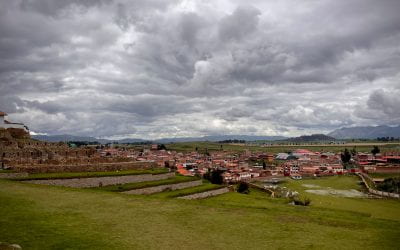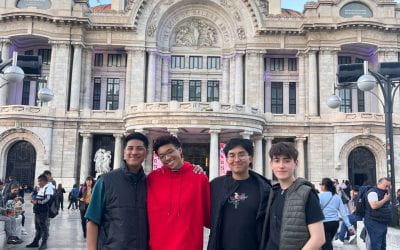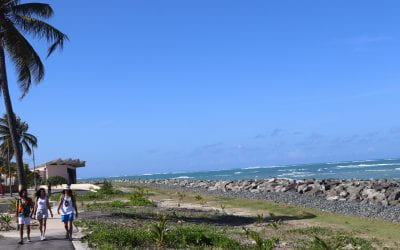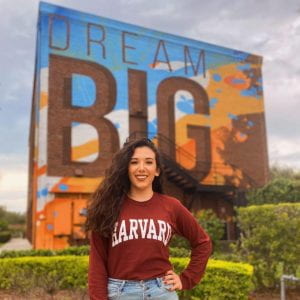
About the Author
Alejandra Salemi is a second-year Master of Theological Studies Student at Harvard Divinity with a concentration on Religion, Ethics, and Politics. She holds a Bachelor’s and Master’s in Public Health from the University of Florida and is passionate about the intersection of public health and religion. She hopes to pursue a Doctorate in Public Health in the near future to further exploring this intersection while also raising awareness and representation of immigrant Latinas in academia.
Living in the Hyphen
What it means to be Colombian-American and how Whiteness plays a part in my identity
I feel like a late bloomer when it comes to exploring my Latinidad. At nearly 25, I have found myself in spaces where I can talk with amigos and fellow classmates on the social identities like Latinx heritage openly and honestly for the first time in my life. It’s shocking, considering that I was born in Bogotá, Colombia, and moved as a young girl to Central Florida where there was great Latinx representation around me. Why has it taken me this long to understand an identity that I think about every day? It’s embarrassing to admit but coming to Harvard, Harvard Divinity School specifically, has been one of the most diverse experiences in my adult life.
It has been shocking, combing back through the journals I have kept since I was a late teen until now and remembering my life growing up, to realize that perhaps the diversity was there but I often didn’t feel connected to it. This could be a product of being raised in a White home and in a White suburban neighborhood. School was a bit more diverse, but the International Baccalaureate path I chose in hopes of it propelling my education meant I wasn’t in class with majority of the populations in my high school, Black and Brown students, but rather in much smaller and curated groups of mostly White and Asian students.
My mom did her best with keeping my Latinidad alive within me. She was constantly filling our home with smells of arepas, maduros, and frijoles from our roots, planning my quinceñera, and yelling at my siblings and me to talk to each other in Spanish (“ESPAÑÑÑÑÑOL,” she would yell from the other room when my siblings and are were hanging out). That cry became a running joke among our family with undertones of appreciation of her being so determined to teach us as much as she could about being Colombian. But the pull to assimilate was strong in the environment of my childhood, an area of Central Florida marked by Deep South conservative thinking and racial bias towards Black and Brown students that I have just now began to realize looking back. Whether it was my friends or the spaces we visited like school or church, it often felt like we were the only Latinos and perhaps I subconsciously accepted to lean into the American part of my Colombian-American identity.
I moved out to go to college and found myself at the University of Florida (UF), the best school in the state but one deeply lacking in its efforts for representing the state’s demographics. Once again, I was in White spaces consistently—the United Methodist campus ministry on campus, my friends, in classes. Perhaps I should have attended the Latinx student group gatherings more, I think about this in hindsight all the time, but internally I felt that I was not Latina enough to comfortably go into those spaces. Perhaps the white-washing of my childhood created deep insecurities of my identity but whatever the reason, I remained in this predominately white institutional space (there’s even an acronym for it—PWI) while putting my Latinidad on the back burner. This is one of the many dances we do while living in the hyphen. Too white to be Latina and too Latina to be white. Colombian | American.
The comfort of passively accepting my Latinidad was most challenged after the 2016 election. The rhetoric of hate, racism and bigotry that was given a platform after the election of Donald Trump instilled a deep fear in me that I had never experienced before. It’s a privilege, I know, to have only come to terms with this threat of violence when I did, but this is by no means to say that my family escaped racist remarks prior 2016. Some members of my family don’t speak English or speak it with a beautiful accent that is, to some, a sign of incompetence or a lack of intelligence. But the election of Trump represented more than that. Living in a county that was full of proud Trump supporters, I feared my mother being harassed or attacked for the way she talked or the language she was speaking. If I was to call her on the phone and we spoke Spanish while she was in a public space, would she be at risk of being racially profiled?
Things only escalated more the Fall of 2017 when Richard Spencer, an alt-right leader and organizer of the deadly Charlottesville rally, came to speak at UF. A man who has made his claim to fame by preaching words of hate and racism, he often speaks about the White supremacy and the dangers of immigration, Latinx people, Islam, women, and pretty much anyone who isn’t a white cisgender heterosexual male. The whole event was pure chaos at UF, which at the time was put under a state of emergency by the governor which led to classes being cancelled, heavy police presence and unimaginable fear from the students of color. This event, taking place in the same building in which I had gone to see a mandatory play for a first-year class, transformed my college town and pushed me to grapple with my Latinidad even more. After all, this was a man who believed that I was taking up seats of White students at this institution (a false notion that a White student later went on to tell me to my face) and who made it abundantly clear that me and mi comunidad were not welcome here. Spencer’s message caused so much turmoil that the “sensible” solution was to post men with snipers atop the student buildings to supervise the protests happening at the event. I ended up attending the counter-protest alone, scared to death but finally realizing that my Latinidad was one of my most cherished qualities and that it deserved to not lay dormant any longer.
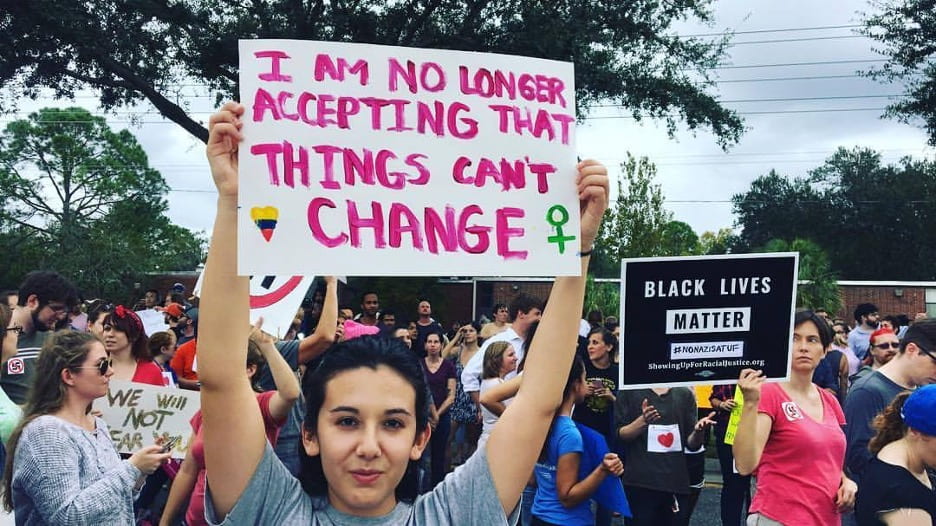
Attending the Richard Spencer protest at the University of Florida on October 19, 2017
I wish I could say that was the only moment of deep racism that forced me out of this assimilated headspace, but it was not. Soon after Richard Spencer, Ben Shapiro and Donald Trump Jr. also came to speak on campus causing similar chaos among the student body. Once again, snipers on top of our student buildings where on a regular weekday, flocks of people would enter to take their dreaded gen eds. The campus once again felt like a hostile zone. I remember watching people who I would sit next to in class or in church or whom I would go out with on the weekends happily enter the auditorium to listen to the latter two speakers talk with so much excitement as I and many other students of color would sit outside of the event halls wondering why this has happening at our institution.
I’ve come a long way with embracing my Latinidad since I was a young girl in Central Florida. Either by external force or by invitation from my own curiosity, I have been able to unpack my understanding and ownership of my identity as a Latina and as an immigrant. But now I find myself pondering it all again.
See, claiming to be Latinx is such a catch-all for such a broad diaspora of lived experiences and though my family has never come from riches, we have always had one unspoken protection: our Whiteness. The Latinx diaspora is really a mestizaje, a mix, of three groups of people: White colonizers from Europe, enslaved people from Africa, and indigenous people who inhabited the land long before it was “discovered.” I finally claim my Latinidad loud and proud but have recently found myself grappling with my next question. How do I toggle the identity of being Latina while also recognizing the privilege of being White passing? And if I’m being brutally honest, how much colonizer do I have in me?
It’s a question I sit with frequently, often left unsatisfied with my limited knowledge of my family lineage that only represents my maternal side and stops after two or three generations back. The question goes beyond a DNA test and looks at the heart of Latinidad: we all don’t experience being Latinx the same. As I am moving through spaces in a mentality that feels much more grounded in a deeper understanding of myself, the privilege I carry as a White-passing Latina keeps me curious about my sense of self. As I seek to advocate for the Latinx community and better representation in our environment, from justice to the farm workers who labor to put food on our tables or calling out horrific wage gaps faced by Latinas or the humanitarian crisis at the Southern border, I find myself coming back frequently to my Whiteness.
I don’t have all of the answers and I likely never will but feel incredibly lucky to have found activist spaces and a community of friends also interested in social justice and equity and are able to help me grow and call me out when I overlook parts of these conversations that exclude anyone from having a seat at the table. The important lessons of intersectionality—how issues and causes intersect— that critical race theorist Kimberlé Crenshaw teaches us reminds me that though I yearn for a day when my Latinidad is represented more in spaces around me, from academia to the pulpit of our religious spaces, I know that true equity will not be reached until we lift from the bottom. As I proudly claim my Latinidad, I hold in my heart the trans, disabled, indigenous and/or Afro-Latinx siblings in our community whom I still have so much to learn from. Perhaps I will never have a complete answer to my questions around my Whiteness, but I hope to continue moving through this hyphen, a Colombian girl who was raised in the United States, with the recognition that I am proud of the community I represent and commit to deconstructing White supremacy that has lived on in the Latin-American community for far too long.
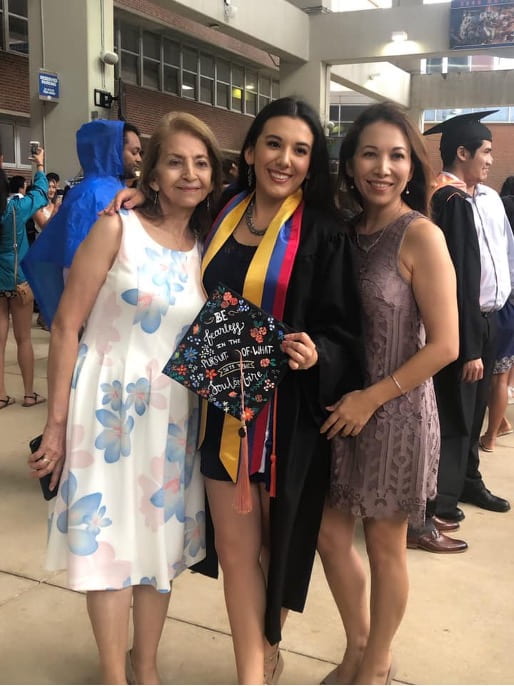
Mi abuela, myself, and mi mamá at my graduation, 2019
More Student Views
Andean Cultural Landscapes in Danger: The Chinchero International Airport
English + Español
Cusco stands as one of the most culturally and ecologically captivating regions globally.
Blossoming Bonds: Beauty and Belonging in Mexico
When I heard the news about my upcoming trip to Mexico, a surge of excitement coursed through me, and I immediately felt the urge to share this exhilarating news with my close friends and family.
Weapons of Mass Construction: Building a Puerto Rico for the People
I zip up my raincoat and turn on my headlamp as we tread along a damp trail in El Yunque National Rainforest, Puerto Rico.

